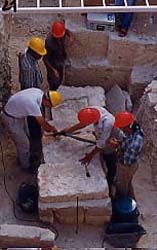ANTHROPOLOGY
Mummies in Alexandria

| Gersende Alix - CEPA (Colmar) | ||
| Eric Boës and Patrice Georges - CEPA*, AFAN** | ||
| Aurore Schmitt, Laboratoire d'Anthropologie, P.Sabatier (Toulouse) |
Since 1998 there have been five missions to excavate and analyse the burials discovered in the tombs of Gabbari district. This paleoanthropological study was conceived from the first activity on site in order to increase the amount of information gathered directly from the bodies, which were often in poor condition. The great number of burials found in certain loculi necessitated a specific methodology that would allow the very precise removal of the bones and any vestiges of embalming. The creation of scaffolding around the pits and loculi permitted an access to the burials while strictly preserving their position of discovery. Initial results swiftly demonstrated that pillaging had not destroyed the large part of burials in the Necropolis.

Revealing evidence of a mummified body through the residues of the embalming process (in dark brown). One can remark the spread of plaster on the front of the haunches which has held an imprint of the general form of the mummy. The poor state of the skull is due embalming practices (removal of the brain and other treatment).
Opening a coffer of limestone slabs
The mass of skeletons in the hypogea of the Gabbari necropolis remains one of the strongest images of the discoveries made by the CEA over the four-year period. Each grave often held several individuals found in situ, as well as the bits of earlier burials that had not been fully emptied out. At first glance there appeared to be a chaotic tangle of more or less fragmentary vestiges, which demanded long hours of piecing together. In this context, each bone was examined with the aim of revealing a part of the functioning of the loculus or pit. By studying hip bones and teeth, the age and sex of the deceased could be identified thus providing information as to the arrangement of the burials in accordance with the above two categories, most notably for infants around the age of one year. In an on-site laboratory set up at the entrance to tomb B17, osteoarchaeological "first aid" was applied to the remains, which involved attributing particular bones to individuals, noting the pathology and analysing fractures. This lab was also used to consolidate the extremely fragile cloth and bindings from the mummies.
| Photos CEA |
| CGI Eric Boës |
| All rights reserved |



Checking traces of cloth on a block of stone and photographing with a digital camera.
Facial imprint on a wad of cloth that once covered a gilded mummy.
First aid applied to bones on site before laboratory analysis.
| * CEPA : Centre d'Etudes des Populations anciennes (Colmar) |
| ** AFAN : Association pour les Fouilles Archéologiques Nationales |